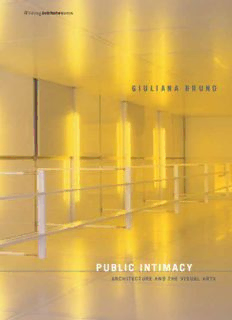
Public Intimacy: Architecture and the Visual Arts (Writing Architecture) PDF
Preview Public Intimacy: Architecture and the Visual Arts (Writing Architecture)
WritingArchitectureseries G I U L I A N A B R U N O PUBLIC INTIMACY ARCHITECTURE AND THE VISUAL ARTS CHAPTER NAME PUBLIC INTIMACY ARCHITECTURE AND THE VISUAL ARTS WritingArchitectureseries A project of the Anyone Corporation Earth Moves: The Furnishing of Territories Bernard Cache, 1995 Architecture as Metaphor: Language, Number, Money Kojin Karatani, 1995 Differences: Topographies of Contemporary Architecture Ignasi de Solà-Morales, 1996 Constructions John Rajchman, 1997 Such Places as Memory: Poems 1953–1996 John Hejduk, 1998 Welcome to the Hotel Architecture Roger Connah, 1998 Fire and Memory: On Arch itecture and Energy Luis Fernández-Galiano, 2000 A Landscape of Events Paul Virilio, 2000 Architecture from the Outside: Essays on Virtual and Real Space Elizabeth Grosz, 2001 Public Intimacy: Architecture and the Visual Arts Giuliana Bruno, 2007 PUBLIC INTIMACY ARCHITECTURE AND THE VISUAL ARTS G I U L I A N A B R U N O THE MIT PRESS CAMBRIDGE, MASSACHUSETTS LONDON, ENGLAND © 2007 Massachusetts Institute of Technology All rights reserved. No part of this book may be reproduced in any form by any electronic or mechanical means (including photocopying, recording, or information storage and retrieval) without permission in writing from the publisher. MIT Press books may be purchased at special quantity discounts for business or sales promotional use. For informa- tion, please email [email protected] or write to Special Sales Department, The MIT Press, 55 Hayward Street, Cambridge, MA 02142. This book was printed and bound in Spain. Library of Congress Cataloging-in-Publication Data Bruno, Giuliana. Public intimac y : architecture and the visual arts / Giuliana Bruno. p. cm. — (Writing architecture) Includes bibliographical references and index. ISBN-13 978-0-262-52465-0 (pbk. : alk. paper) 1. Art and architecture. 2. Art and motion pictures. I. Title. N72.A75B78 2007 720.1—dc22 2006046723 10 9 8 7 6 5 4 3 2 1 for Annette Michelson CONTENTS FOREWORD Anthony Vidler ix ACKNOWLEDGMENTS xiii RECOLLECTED SPACES 1.Collection and Recollection: 3 On Film Itineraries and Museum Walks 2.Modernist Ruins, Filmic Archaeologies: 43 Jane and Louise Wilson’s A Free and Anonymous Monument SCIENTIFIC SCENOGRAPHIES 3.The Architecture of Science in Art: An Anatomy Lesson 87 4.Mind Works: Reb ecca Horn’s Interior Art 119 FABRICS OF TIME 5.Fashions of Living: Intimacy in Art and Film 163 6.Architects of Time: Reel Duration from Warhol 189 to Tsai Ming-liang NOTES 215 INDEX 237 FOREWORD Three-dimensional space, inhabited and set in virtual motion by the body, has formed the material of modern architecture; its representation in two dimensions, with the added dimension of time, has been the work of film. Both arts have been inextricably linked since the end of the nineteenth century: architects have taken their cue from film, filmmakers from architects. Sigfried Giedion coined the triplet “space, time, and architecture”; Le Corbusier and Sergei Eisenstein served as the emblematic duo in this cross-medium relationship; Walter Benjamin sealed the marriage as a product of modern technological reproduction; and psychology reinforced it with the concept of mental projection. Architecture now operated as a psychic mechanism, constructing its subjects in time and space. Film not only depicted movement in space and space in movement, it also unpacked the modern subject’s spatial unconscious and its layers of (repressed) mem- ories. These are the arenas in which film theorist Giuliana Bruno focuses her critical analysis of bodies, space, and the projection of two-dimensional pictures, both moving and still. While modernism in architecture and the then-new medium of film have served as the leitmotif of the avant-gardes since the 1900s, the intersection of mental-spatial experience and its illusory depiction has a long prehistory in the phantasmagoria of nineteenth-century panoramas, the anatomy theaters of early medical presentation, and the memory theaters of the Renais- sance that Bruno considers. The psychoanalyst Jacques Lacan even traced it back to the very origins of architecture and painting where, as he noted, architecture primitively “organized around a
Description: